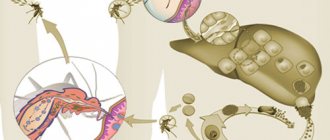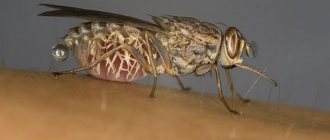Babesia is a type of intracellular parasite that infects the red blood cells of cattle, domestic animals such as dogs and humans.
Protozoa of the genus protists cause a transmissible invasive disease, defined as babesiosis, from the Latin Babesiosis. Babesiosis in humans is a fairly rare disease, but the spread of the parasitic pathogen affects almost every region of the globe, except Antarctica. In the Russian Federation, babesiosis in cattle, domestic animals and humans is most common in the northwestern and steppe regions. Parasitic infection occurs through a transmissible route, that is, with the help of living blood-sucking carriers. The causative agent of babesiosis in humans is Babesia divergens, in cattle - Babesia divergens (bovis), and in dogs - Babesia canis.
Piroplasmosis in dogs
Protozoan blood parasites from the genus Babesia cause a seasonal disease in pets, defined as piroplasmosis (babesiosis). The infectious vector of infection is the ixodid tick, of which there are over 650 species in nature. Parasitiform bloodsuckers are also carriers of tick-borne borreliosis, or Lyme disease, and tick-borne encephalitis. The life cycle of the simplest microorganisms proceeds with a change of two hosts, among which the main intermediate owner is a dog, and the definitive owner is a tick. Babesiosis, or piroplasmosis, occurs in a dog after being bitten by an infected tick.
The parasitic disease most often manifests itself in animals in early spring, after the snow melts, or in autumn, before the onset of cold weather. Dogs of all ages and breeds are susceptible to invasive infection. However, puppies and young purebred dogs under the age of 4 years are more susceptible to infection with piroplasmosis. The incubation period for parasitic reproduction in animals can last from 2-3 days to 2-3 weeks. Once in the dog's blood, infected microorganisms begin to actively multiply, causing destruction in red blood cells - erythrocytes. The decay products of Babesia are very toxic to the body of mammals.
Attention! Delayed medical care for an animal can lead to death.
Therefore, diagnosis of babesiosis (pyroplasmosis) in dogs should be carried out within 5-7 days from the moment of the first clinical manifestations of infection. Symptoms of the acute course of a parasitic disease are manifested by the following conditions and signs:
- the dog’s body temperature remains within 40-42ºC for 2-3 days;
- the animal's pulse and breathing are rapid;
- there is a complete lack of interest in food and water;
- the oral cavity and whites of the eyes acquire a jaundiced tint;
- the animal's urine is reddish or brown;
- frequent diarrhea occurs, in which there is blood in the stool;
- the animal constantly burps, releasing a bright yellow or greenish liquid.
During illness, the dog becomes lethargic, and the desire to move is completely absent. A confirmatory factor of infection is laboratory diagnosis of malaria and babesiosis as a possible cause-and-effect relationship of the clinical manifestations that have arisen. Only after the corresponding pathogen is detected in the red blood cells of the blood is piroplasmosis treated. All medical procedures are provided by a veterinarian who uses special pharmacological drugs aimed at eliminating pain syndromes and removing general intoxication in the animal’s body. Due to the fact that the disease is becoming widespread, the All-Russian Research Institute of Experimental Veterinary Medicine has developed a special treatment and prophylactic method for canine babesiosis. Dissertations and scientific works of Russian and European scientists were heard at the XXV Moscow International Veterinary Congress, which took place at the end of April 2020.
The causative agent of infection
The causative agent of piroplasmosis is single-celled parasites that infect blood cells. The place of their localization is erythrocytes. One erythrocyte sometimes contains from 2 to 32 infectious agents, filling the entire erythrocyte. When the body is severely affected by piroplasmosis, Babesia is diagnosed even in the blood plasma.
The carriers of the disease are ixodid ticks, which are in the stage of sexual maturity. The most favorable conditions for ticks to reproduce and become infected with piroplasmosis are regions with a humid and hot climate.
Is it possible to get piroplasmosis from a dog ? Babesiosis in humans is rare, but cases of infection with certain types of Babesia have been recorded, but they are not transmitted from a dog.
Bovine piroplasmosis (cattle)
Chikhir, Texas fever, piroplasmosis and babesiosis are all names of one vector-borne disease of artiodactyls caused by parasitic babesia, or piroplasma. The microscopic parasite begins its developmental life in the organisms of two potential carriers - cattle and tick vectors. Reproduction of piroplasm in the body of artiodactyls occurs through vegetative division in the internal organs of the animal, and then circulates through vessels outside the hematopoietic organs. Symptoms of bovine babesiosis are very common in the southern regions of the Russian Federation, but the parasitic disease can also be found in the central regions of the country. Epidemic outbreaks of infection occur in the spring-summer period, and sometimes in early autumn. The incubation period of piroplasmosis infection lasts about 30 days.
Characteristic signs of acute (less often chronic) course of parasitic infection:
- the animal’s body temperature exceeds 40 degrees Celsius;
- the mucous membrane of the tongue and the whites of the eyes has an icteric tint;
- the animal stops eating and refuses water;
- urine in cattle on the 3-4th day of infection acquires a dark brown tint;
- a depressed state and weakened physical activity in animals leads to cachexia.
If the symptoms of infection are not recognized in time, then after 5-7 days the animal dies. Piroplasmosis is determined on the basis of epizootological data obtained in laboratory conditions. For bovine babesiosis, treatment is carried out by injection of various drugs, for example, Adizin and Diamedin. To maintain vitamin balance, vitamin B12 is injected into the animal’s blood, and to ensure respiratory activity, the respiratory stimulant Sulfocamphocaine is injected into the medulla oblongata. To ensure the safety of animals from parasitic infection, there are specially developed methods of therapeutic prevention. Cattle are grazed in areas that have been pre-treated with repellents. When kept in stalls, animals are bathed or sprayed with emulsion acaricides every 7 days. With proper organization of treatment, preventive, organizational, economic and veterinary work, the risk of infection is reduced to a minimum.
3. Symptoms and diagnosis
Clinically significant symptoms arise from the moment when the proportion of infected and doomed red blood cells in the blood exceeds 35% (in the most severe cases, this proportion rapidly increases, reaching several tens of percent, which leaves practically no chance for the infected person). Depending on the specific pathogen, the disease can manifest itself with fever, almost always with high or very high temperature, headache and/or abdominal pain, general malaise, weakness, digestive and appetite disorders, myalgia, and other symptoms of general intoxication. Symptoms of anemia develop; with further expansion of the parasite, severe disturbances in metabolism, tissue oxygenation, microcirculation may occur, as well as progressive renal failure, hematuria, further complicating pneumonia, etc. In the absence of etiotropic treatment, such patients die.
However, in immunocompetent individuals, babesiosis is usually asymptomatic.
Diagnosis is often difficult, especially when the concentration of the pathogen in the blood is low. Carefully study the medical history (stay in epidemic foci, dynamics of deterioration of the condition, recent illnesses, injuries or operations, etc.). The parasitological method is used (microscopic visualization of active individuals in a drop of blood), indirect fluorescence reaction, etc. Sometimes, with a clinically justified, but not objectively confirmed, suspicion of chronic asymptomatic babesiosis, it is necessary to resort to artificial infection of laboratory hamsters lacking a spleen with the patient’s blood. A positive result, i.e. confirmation of parasitosis, in this case, is the detection of Babesia in the blood of animals after 2-3 weeks.
About our clinic Chistye Prudy metro station Medintercom page!
Babesiosis (pyroplasmosis) in humans
Unfortunately, not only animals, but also humans are susceptible to infection. The risk group includes workers of fur farms and dog kennels, rural residents, shepherds and “green” tourists. Over the half-century history of the disease, which was first discovered in 1957 by Yugoslav scientists, about 150 cases of babesiosis infection have been recorded. Unfortunately, most cases of infection were fatal. The thing is that with the full functioning of the immune defense, the course of the disease is asymptomatic. Only 5% of people infected with babesiosis (those with immunological problems) react sensitively to the acute form of infection.
Clinical signs of babesiosis infection
The incubation period after an infected tick bite lasts 10-14 days. If 5% of all red blood cells in the blood are affected, symptoms of the disease appear after 6-10 days. The initial phase of infection is characterized by a state of acute respiratory disease:
- body temperature is kept within subfebrile limits;
- general weakness and weakness of the body are felt;
- pulse and breathing increase;
- chills, fever and active sweating;
- muscle pain.
During this period, a person’s hemoglobin level sharply decreases, interest in food completely disappears, and signs of anemia develop. Taking antiviral drugs does not imply a positive effect. If babesiosis is not treated in a timely manner at this stage of infection, the next phase begins, which is expressed in more aggressive symptoms:
- A person’s body temperature suddenly rises to 41-42˚C, which lasts for 7-8 days, and then suddenly drops to subfebrile limits.
- The destruction of red blood cells leads to acute hemolysis. The skin acquires a jaundiced tint.
- General intoxication of the body is observed.
- Heart rhythm is modified.
- Photophobia appears.
- The human liver and spleen increase in size.
- Due to impaired renal function, urine becomes dark brown in color.
Attention! Without medical care at this stage of the disease, the risk of death is 100%.
How is babesiosis diagnosed?
Diagnosing invasive transmission at the initial stage of infection is quite difficult. Clinical symptoms have a number of nonspecific signs that are not amenable to antibacterial treatment. Only high-quality bacteriological and immunofluorescent analysis of babesiosis allows us to obtain a complete informative picture of a person’s condition. The most effective, but rather expensive diagnostic method is the polymerase chain reaction method. Confirmation of clinical signs of babesiosis is the presence of babesia in the blood with a diagnostic titer of 1:255.
Treatment of babesiosis (pyroplasmosis) in humans
Invasive disease is a fairly rare and not fully understood transmissible human pathology. Therefore, there is no single treatment regimen for babesiosis. The complex of therapeutic measures is based on the individual characteristics of the patient, his physiology, age criteria, gender and symptoms. The mild stage of infection tends to heal itself when a protective immunological reaction is triggered. An integrated therapeutic approach is justified in severe cases of infection. The general scheme of drug treatment is selected according to the principle of reactionary suppression of specific symptoms:
- Impaired renal function requires hemodialysis and a course of therapeutic therapy with diuretic drug groups.
- Signs of anemia are eliminated by introducing a large number of new red blood cells into the patient's blood.
- The painful state of the liver is corrected with hepatoprotectors.
- If the hemoglobin level drops below 73 g/l, a general blood transfusion is recommended.
Among the effective drugs for treating severe forms of babesiosis in humans, pharmacological combinations are recommended:
- Azithromycin and Atovaquone.
- Quinine sulfate and Clindamycin.
Azithromycin is a semi-synthetic dosage form with bacteriostatic and antibacterial effects. The drug is active against gram-positive microorganisms. Contraindications: renal and/or liver failure, children under 12 years of age, pregnant and lactating women.
Atovaquone is a pharmacological drug with antiprotozoal activity for oral administration. The dosage form has a detrimental effect on various types of parasitic infections: pneumocystis, toxoplasma, malarial plasmodium, babesia and microsporidia. Contraindications: pregnancy and hypersensitivity to the active ingredient.
Quinine sulfate is a drug that has an antipyretic and analgesic effect. The main active ingredient is the sulfate salt of the alkaloid quinine, which is obtained from the bark of the cinchona tree. The drug has pronounced activity against Babesia and malarial Plasmodium. The dosage form is prescribed with caution to children under 15 years of age, pregnant and lactating women, elderly and senile people, as well as HIV-infected patients.
Clindamycin is a semisynthetic drug with antimicrobial activity. The drug inhibits the growth of living cells of microorganisms at the initial stage of their development. The drug is not recommended for people with chronic diseases of the respiratory system, patients with gastrointestinal problems, and is also contraindicated for autoimmune neuromuscular diseases.
Causes of the disease
The causative agent of the pathology belongs to the type of protozoa, the class of Sporozoans.
Cattle can be infected with this type of babesiosis, such as Babesia divergens.
There are more than one hundred types of babesiosis, but the most common are four types:
- Babesia divergens (bovis) - cattle
- Babesia ovis - sheep
- Babesia canis - dogs
- Babesia divergens (Europe) - human.
After entering the body of an animal or a person, the protozoa migrate inside the red blood cells, located in the central part or along the periphery. Diagnostics allows you to identify babesiosis by characteristic rings and pear-shaped formations, which are revealed by Gram stain.
One hundred cases of babesiosis are known in medical practice, all of them leading to the death of the infected person. The symptoms of the pathology are most acute and pronounced in people with weakened immune systems; first of all, HIV-infected people are at risk. With normal functioning of the immune system, the pathology is asymptomatic.
It is important! The large number of infected people is explained by the fact that diagnostics in modern medicine make it possible to identify parasites in the body with a high degree of effectiveness.
The symptoms of the pathology are most acute and pronounced in people with weakened immune systems.
How to fight babesiosis (pyroplasmosis)?
It should be noted that there is no vaccine against babesiosis. In addition, treatment with folk remedies for babesiosis (piroplasmosis) is absolutely ineffective. How to protect yourself from the risk of infection with an invasive disease?
On a note! The only prevention of babesiosis is the use of anti-tick medications belonging to the group of acaricides.
In addition, before going into the forest or when in contact with wild and/or domestic animals, it is recommended to choose the right clothing that will protect you from a tick bite. After traveling and walking through tick habitats, you should carefully inspect your clothing and body.
Take care of yourself and be healthy!
Treatment of babesiosis
People who are diagnosed with babesiosis but do not have symptoms of babesiosis may not need treatment. These people must donate their blood to ensure they are cleared of parasites.
People with symptoms of babesiosis who have a confirmed Babesia infection usually require a 7-10 day course of anti-parasitic medications, usually:
- atovaquone,
- azithromycin,
- clindamycin,
- quinine.
Physicians should seek the advice of an infectious disease specialist when considering the diagnosis and treatment of babesiosis.
Signs of the disease
The incubation period of babesiosis is from 10 to 15 days; if infection occurs through blood, the first symptoms appear earlier - after 6-12 days:
- the temperature rises sharply to +40 degrees;
- breathing becomes frequent and intermittent;
- heart rhythm is lost;
- the patient loses weight.
The course of the disease is very varied and depends on the initial state of health of the patient and the severity of the pathology.
The first symptoms of the disease appear earlier – after 6-12 days. A person may lose weight suddenly.
In some cases, a person is not even aware of the parasites, and sometimes babesiosis leads to long-term treatment.
Main symptoms:
- fever;
- fast fatiguability;
- splenomegaly;
- excessive sweating and chills;
- pain in joints and muscles;
- nausea and vomiting;
- depressed emotional state;
- headache;
- pain in the throat and stomach;
- fear of light;
- cough.
The clinical picture in children and adult patients is no different.
It is important! Unlike other pathologies that are transmitted by ticks, babesiosis does not cause a rash.
Very often, the main symptom of babesiosis is a cough.
The disease manifests itself most severely and for the longest time in patients over 50 years of age. Quite often, patients are diagnosed with a mixed infection, since babesiosis develops together with other infectious pathologies - granulocytic ehrlichiosis and Lyme disease. In this case, the symptoms are very diverse.
It is important! In medical practice, there have been cases where the disease was asymptomatic in the patient’s body for several years. However, this does not mean that a person does not need effective treatment. After all, pathology can provoke the development of complications - renal failure and multiple organ failure.
How to treat piroplasmosis
Despite the fact that injections against piroplasmosis for animals have been successfully used for several years, an effective method for treating the disease in humans has not yet been developed . According to studies of registered cases of invasion, the most effective treatment results were observed when using the following combinations of medications:
- Azithromycin and Atovaquone;
- Clarithromycin and quinine;
- pentamidine diisocyanate and cotrimoxazole.
In addition, some specialists successfully use symptomatic therapy. So, in case of liver damage, hepatoprotectors (Heptral, Phosgliv) are prescribed. In case of anemia and a serious decrease in hemoglobin level, red blood cell transfusion is performed. In case of acute renal failure, the patient is prescribed hemodialysis.
Important. Treatment with drugs for piroplasmosis is possible only in case of laboratory confirmation of Babesia infestation.
Loop diuretics are prescribed to patients with piroplasmosis when kidney function is impaired.
Pathogenesis of the disease
Unfortunately, the pathogenesis has not been studied enough; it is known for certain that the disease is transmitted through insect bites and blood.
Almost all ticks are carriers of the pathogen, which enters the host through the saliva of the insect.
The natural host for the pathogen is animals; the parasite uses the body of small rodents as an intermediate host.
After infection, the animal does not show symptoms of acute babesiosis for three years; there are areas in the world where the entire livestock population is infected with parasites.
After a tick bite, the protozoa spread throughout the circulatory system and penetrate the capillaries and red blood cells. This is where parasites multiply and damage blood cells. Symptoms of the disease appear when the concentration of affected red blood cells exceeds 4%.
As a result of the destruction of red blood cells, a number of pathological processes occur in the body, which lead to renal failure.
As a result of the destruction of red blood cells, a number of pathological processes occur in the body:
- severe intoxication caused by the entry into the blood of waste products of pathogenic microflora;
- anemia accompanied by a lack of oxygen;
- The membranes of destroyed blood cells and free hemoglobin accumulate, as a result, traces of blood appear in the urine and kidney failure develops.
Prevention
There is no vaccination against piroplasmosis, so the main preventive measure in the fight against the disease is to prevent tick bites.
Important. When going out into nature, you should carefully select the right clothing and avoid areas where ticks are widespread.
Although pets cannot infect humans, they should be protected from insect bites by using special repellents or collars. When an animal becomes infected, it is treated with injections or droppers for piroplasmosis for animals.
Municipal authorities should take care of the timely treatment of public gardens and parks from ixodid ticks.
The symptoms of Babesia infection in the human body have not been fully studied, and there are no drugs for etiotropic therapy. However, timely recognition of the disease and contacting a specialist will help avoid damage to internal organs or death.
People should be careful with pets, which are also carriers of various diseases. Babesiosis is transmitted through transmission by transferring pasture ticks from an animal or person to another person. The main symptoms are fever, anemia, hemoglobin in the blood and intoxication of the body. It is simply impossible to do without treatment and prevention.
The website slovmed.com indicates the prevalence of the disease throughout the planet. Only in Antarctica is this disease not observed. Babesiosis mainly affects people in eastern America, southern Europe, and Russia (in the south, northwest and Siberia).
Among the carriers are rodents, livestock, dogs, and cats. Most often, the disease is observed in people who spend a lot of time outdoors: tourists, rural residents, agricultural workers, travelers, etc.











